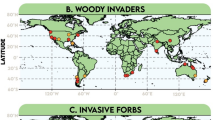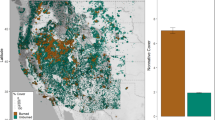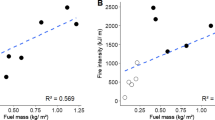Abstract
Fire regimes influence and are influenced by the structure and composition of plant communities. This complex reciprocal relationship has implications for the success of plant invasions and the subsequent impact of invasive species on native biota. Although much attention has been given to the role of invasive grasses in transforming fire regimes and native plant communities, little is known about the relationship between woody invasive species and fire regime. Despite this, prescribed burning is frequently used for managing invasive woody species. In this study we review relationships between woody exotic plant invasions and fire in invaded ecosystems worldwide. Woody invaders may increase or decrease aspects of the fire regime, including fire frequency, intensity and extent. This is in contrast to grass invaders which almost uniformly increase fire frequency. Woody plant invasion can lead to escape from a grass-fire cycle, but the resulting reduction in fire frequency can sometimes lead to a cycle of rare but more intense fires. Prescribed fires may be a useful management tool for controlling woody exotic invaders in some systems, but they are rarely sufficient to eliminate an invasive species, and a dearth of controlled experiments hampers evaluation of their benefits. Nevertheless, because some woody invaders have fuel properties that differ substantially from native species, understanding and managing the impacts of woody invaders on fire regimes and on prescribed burns should become an important component of resource and biodiversity management.

Similar content being viewed by others
References
Alexander J, D’Antonio C (2003a) Control methods for the removal of French and Scotch broom tested in coastal California. Ecol Restor 21:191–198
Alexander JM, D’Antonio CM (2003b) Seed bank dynamics of French broom in coastal California grasslands: effects of stand age and prescribed burning on control and restoration. Restor Ecol 11:185–197
Allen HD (2008) Fire: plant functional types and patch mosaic burning in fire-prone ecosystems. Prog Phys Geogr 32:421–437
Batcher MS (2000) Element Stewardship Abstract for Ligustrum spp. In: Tu M, Meyers-Rice B, Randall JM (eds) Element stewardship abstracts. The Nature Conservancy, Arlington
Bebawi FF, Campbell SD (2002) Impact of early and late dry-season fires on plant mortality and seed banks within riparian and subriparian infestations of rubber vine (Cryptostegia grandiflora). Aust J Exp Agric 42:43–48
Bond WJ, Keeley JE (2005) Fire as a global ‘herbivore’: the ecology and evolution of flammable ecosystems. Trends Ecol Evol 20:387–394
Bossard CC (2000) Cytisus scoparius. In: Bossard CC, Randall JM, Hoshovsky MC (eds) Invasive plants of California’s Wildlands. University of California Press, Berkeley, pp 145–150
Boyd D (1997) Eucalyptus removal on Angel Island. In: Kelly M, Wagner E, Warner P (eds) California exotic pest plant council symposium. California Exotic Pest Plant Council, Concord, pp 73–75
Boyd D, Rafael S (1995) Use of fire to control French broom. In: Lovich JE, Randall J, Kelley MD (eds) California exotic pest plant council symposium. California Exotic Pest Plant Council, Pacific Grove, pp 9–12
Braithwaite RW, Lonsdale WM, Estbergs JA (1989) Alien vegetation and native biota in tropical Australia: the impact of Mimosa pigra. Biol Conserv 48:189–210
Brock JH (1994) Tamarix spp. (salt cedar), an invasive exotic woody plant in arid and semi-arid riparian habitats of western USA. Ecology and management of invasive riverside plants. Wiley, New York, pp 27–44
Brooks ML, D’Antonio CM, Richardson DM, Grace JB, Keeley JE, DiTomaso JM, Hobbs RJ, Pellant M, Pyke D (2004) Effects of invasive alien plants on fire regimes. Bioscience 54:677–688
Busch DE (1995) Effects of fire on southwestern riparian plant community structure. Southwest Nat 40:259–267
Busch DE, Smith SD (1993) Effects of fire on water and salinity relations of riparian woody taxa. Oecologia 94:186–194
Campbell S, Setter C (2002) Mortality of Prosopis pallida (mesquite) following burning. Aust J Exp Agric 42:581–586
Certini G (2005) Effects of fire on properties of forest soils: a review. Oecologia 143:1–10
D’Antonio CM (2000) Fire, plant invasions and global change. In: Mooney HA, Hobbs RJ (eds) Invasive species in a changing world. Island Press, Washington, pp 65–93
D’Antonio CM, Vitousek PM (1992) Biological invasions by exotic grasses, the grass/fire cycle, and global change. Ann Rev Ecol Syst 23:63–87
Dicus CA, Anderson MP (2004) Benefits versus fire risk of native and invasive vegetation in the wildland-urban interface. In: Pirosko C (ed) California invasive plant council symposium. California Invasive Plant Council, Ventura, pp 63–70
Didham RK, Tylianakis JM, Hutchison MA, Ewers RM, Gemmell NJ (2005) Are invasive species the drivers of ecological change? Trends Ecol Evol 20:470–474
Dimitrakopoulos A, Papaioannou KK (2001) Flammability assessment of Mediterranean forest fuels. Fire Technol 37:143–152
DiTomaso JM, Brooks ML, Allen EB, Minnich R, Rice PM, Kyser GB (2006) Control of invasive weeds with prescribed burning. Weed Technol 20:535–548
Dooley T (2003) Lessons learned from eleven years of prescribed fire at the Albany Pine Bush Preserve. In: Bennett KP, Dibble AC, Patterson WA (eds) Using fire to control invasive plants: what’s new, what works in the Northeast. University of New Hampshire Cooperative Extension, Durham
Doren RF, Whiteaker LD (1990) Effects of fire on different size individuals of Schinus terebinthifolius. Nat Areas J 10:107–113
Doren RF, Whiteaker LD, Larosa AM (1991) Evaluation of fire as a management tool for controlling Schinus terebinthifolius as secondary successional growth on abandoned agricultural land. Environ Manag 15:121–129
Downey PO, Smith JMB (2000) Demography of the invasive shrub Scotch broom (Cytisus scoparius) at Barrington Tops, New South Wales: insights for management. Austral Ecol 25:477–485
Ellis LM, Crawford CS, Molles MC Jr (1998) Comparison of litter dynamics in native and exotic riparian vegetation along the Middle Rio Grande of central New Mexico, U.S.A. J Arid Environ 38:283–296
Esler KJ, van Wilgen BW, te Roller KS, Wood AR, van der Merwe JH (2010) A landscape-scale assessment of the long-term integrated control of an invasive shrub in South Africa. Biol Invasions 12:211–218
Fisher JL, Loneragan WA, Dixon K, Delaney J, Veneklaas EJ (2009) Altered vegetation structure and composition linked to fire frequency and plant invasion in a biodiverse woodland. Biol Conserv 142:2270–2281
Glasgow LS, Matlack GR (2007) The effects of prescribed burning and canopy openness on establishment of two non-native plant species in a deciduous forest, southeast Ohio, USA. For Ecol Manag 238:319–329
Gleadow R, Narayan I (2007) Temperature thresholds for germination and survival of Pittosporum undulatum: implications for management by fire. Acta Oecol 31:151–157
Gordon DR (1998) Effects of invasive, non-indigenous plant species on ecosystem processes: lessons from Florida. Ecol Appl 8:975–989
Grace JB (1998) Can prescribed fire save the endangered coastal prairie ecosystem from Chinese tallow invasion? Endanger Species Update 15:70–76
Grice A (1997) Post-fire regrowth and survival of the invasive tropical shrubs Cryptostegia grandiflora and Ziziphus mauritiana. Austral Ecol 22:49–55
Grice AC, Radford IJ, Abbott BN, Nicholas DM, Whiteman L (2008) Impacts of changed fire regimes on tropical riparian vegetation invaded by an exotic vine. Austral Ecol 33:151–167
Hiremath AJ, Sundaram B (2005) The fire-lantana cycle hypothesis in Indian forests. Conserv Soc 3:26–42
Holmes PM, MacDonald IAW, Juritz J (1987) Effects of clearing treatment on seed banks of the alien invasive shrubs Acacia saligna and Acacia cyclops in the southern and south-western Cape, South Africa. J Appl Ecol 24:1045–1051
Holmes PM, Richardson DM, Van Wilgen BW, Gelderblom C (2000) Recovery of South African fynbos vegetation following alien woody plant clearing and fire: implications for restoration. Austral Ecol 25:631–639
Keeley JE (2001) Fire and invasive species in Mediterranean-climate ecosystems of California. In: Galley K, Wilson T (eds) Invasive species workshop: the role of fire in the control and spread of invasive species. Tall Timbers Research Station, Tallahasse, pp 81–94
Keith DA, Williams JE, Woinarski JCZ (2002) Fire management and biodiversity conservation: key approaches and principles. Flammable Australia: the fire regimes and biodiversity of a continent. Cambridge University Press, Cambridge, pp 401–425
Lonsdale WM, Miller IL (1993) Fire as a management tool for a tropical woody weed: Mimosa pigra in Northern Australia. J Environ Manag 39:77–87
MacDougall AS, Turkington R (2005) Are invasive species the drivers or passengers of change in degraded ecosystems? Ecology 86:42–55
Moritz MA, Morais ME, Summerell LA, Carlson JM, Doyle J (2005) Wildfires, complexity, and highly optimized tolerance. Proc Natl Acad Sci U S A 102:17912–17917
Murphy A, Lusk W (1961) Timing medusahead burns: to destroy more seed—save good grasses. Calif Agric 15:6–7
Myers RL, Belles HA, Snyder JR (2000) Prescribed fire in the management of Melaleuca quinquenervia in subtropical florida. In: Galley KEM, Wilson TP (eds) Invasive species workshop: the role of fire in the control and spread of invasive species. Tall Timbers Research Station, Tallahassee, pp 132–140
Nagler PL, Hinojosa-Huerta O, Glenn EP, Garcia-Hernandez J, Romo R, Curtis C, Huete AR, Nelson SG (2005) Regeneration of native trees in the presence of invasive saltcedar in the Colorado River Delta, Mexico. Conserv Biol 19:1842–1852
Pauchard A, García RA, Pena E, González C, Cavieres LA, Bustamante RO (2008) Positive feedbacks between plant invasions and fire regimes: Teline monspessulana (L.) K. Koch (Fabaceae) in central Chile. Biol Invasions 10:547–553
Pausas JG, Keeley JE, Verdú M (2006) Inferring differential evolutionary processes of plant persistence traits in Northern Hemisphere Mediterranean fire-prone ecosystems. J Ecol 94:31–39
Paynter Q, Flanagan GJ (2004) Integrating herbicide and mechanical control treatments with fire and biological control to manage an invasive wetland shrub, Mimosa pigra. J Appl Ecol 41:615–629
Peterson DW, Reich PB (2007) Fire frequency and tree canopy structure influence plant species diversity in a forest-grassland ecotone. Plant Ecol 194:5–16
Pieterse P, Boucher C (1997) Is burning a standing population of invasive legumes a viable control method? Effects of a wildfire on an Acacia mearnsii population. South Afr For J 180:15–21
Pieterse P, Cairns A (1988) The population dynamics of the weed Acacia longifolia (Fabaceae) in the absence and presence of fire. S Afr For J 145:25–27
Radford IJ, Nicholas DM, Brown JR (2001) Impact of prescribed burning on Acacia nilotica seed banks and seedlings in the Astrebla grasslands of northern Australia. J Arid Environ 49:795–807
Radford IJ, Grice AC, Abbott BN, Nicholas DM, Whiteman L (2008) Impacts of changed fire regimes on tropical riparian vegetation invaded by an exotic vine. Austral Ecol 33:151–167
Rahlao SJ, Milton SJ, Esler KJ, Van Wilgen BW, Barnard P (2009) Effects of invasion of fire-free arid shrublands by a fire-promoting invasive alien grass (Pennisetum setaceum) in South Africa. Austral Ecol 34:920–928
Rice PM (2004) Fire as a tool for controlling nonnative invasive plants. Center for Invasive Plant Management, Missoula, pp 1–52
Richardson DM (1988) Age structure and regeneration after fire in a self-sown Pinus halepensis forest on the Cape Peninsula, South Africa. S Afr J Bot 54:140–144
Richburg J, Dibble A, Patterson W (2000) Woody invasive species and their role in altering fire regimes of the Northeast and Mid-Atlantic states. In: Galley KEM, Wilson TP (eds) Invasive species workshop: the role of fire in the control and spread of invasive species. Tall Timbers Research Station, Tallahassee, pp 104–111
Richburg JA, Patterson III WA, Ohman M (2004) Fire management options for controlling woody invasive plants in the northeastern and mid-Atlantic US. Joint Fire Science Program Northeast Barrens Fuels Demonstration Project. http://www.umass.edu/nebarrensfuels/publications/pdfs/Richburg_Ohman-Invasives_Fire_final_report.pdf. Accessed 25 April 2011
Schierenbeck K (2004) Japanese honeysuckle (Lonicera japonica) as an invasive species; history, ecology, and context. Crit Rev Plant Sci 23:391–400
Schwilk DW, Ackerly DD (2001) Flammability and serotiny as strategies: correlated evolution in pines. Oikos 94:326–336
Serbesoff-King K (2003) Melaleuca in Florida: a literature review on the taxonomy, distribution, biology, ecology, economic importance and control measures. J Aquat Plant Manag 41:98–112
Shafroth PB, Cleverly JR, Dudley TL, Taylor JP, van Riper C, Weeks EP, Stuart JN (2005) Control of Tamarix in the western United States: implications for water salvage, wildlife use, and riparian restoration. Environ Manag 35:231–246
Sharma G, Raghubanshi A, Singh J (2005) Lantana invasion: an overview. Weed Biol Manag 165:157–165
Silvers CS, Pratt PD, Center TD (2007) T.A.M.E. Melaleuca: a regional approach for suppressing one of Florida’s worst weeds. J Aquat Plant Manag 45:1–8
Simberloff D, Nuñez MA, Ledgard NJ, Pauchard A, Richardson DM, Sarasola M, Van Wilgen BW, Zalba SM, Zenni RD, Bustamante R (2010) Spread and impact of introduced conifers in South America: lessons from other southern hemisphere regions. Austral Ecol 35:489–504
Stevens JT, Beckage B (2009) Fire feedbacks facilitate invasion of pine savannas by Brazilian pepper (Schinus terebinthifolius). New Phytol 184:365–375
Stevens JT, Beckage B (2010) Fire effects on demography of the invasive shrub Brazilian pepper (Schinus terebinthifolius) in Florida pine savannas. Nat Areas J 30:53–63
Swezy M, Odion DC (1997) Fire on the mountain: a land manager’s manifesto for broom control. In: Kelly M, Wagner E, Warner P (eds) California exotic pest plant council symposium. California Exotic Pest Plant Council, Concord, pp 76–81
Turner CE, Center TD, Burrows DW, Buckingham GR (1997) Ecology and management of Melaleuca quinquenervia, an invader of wetlands in Florida, USA. Wetl Ecol Manag 5:165–178
Tveten R, Fonda R (1999) Fire effects on prairies and oak woodlands on Fort Lewis, Washington. Northwest Sci 73:145–158
van Wilgen BW, Richardson DM (1985) The effects of alien shrub invasions on vegetation structure and fire behaviour in South African fynbos shrublands: a simulation study. J Appl Ecol 22:955–966
van Wilgen BW, Nel JL, Rouget M (2007) Invasive alien plants and South African rivers: a proposed approach to the prioritization of control operations. Freshw Biol 52:711–723
Ward JS, Worthley TE, Williams SC (2009) Controlling Japanese barberry (Berberis thunbergii DC) in southern New England, USA. For Ecol Manag 257:561–566
Whelan R (1995) The ecology of fire. Cambridge University Press, New York 346 pp
Williams M, Wardle G (2005) The invasion of two native Eucalypt forests by in the Blue Mountains, New South Wales, Australia. Biol Conserv 125:55–64
Zalba SM, Villamil CB (2002) Woody plant invasion in relictual grasslands. Biol Invasions 4:55–72
Acknowledgments
We thank Christopher Hu and two anonymous reviewers for comments on the text. J.L.B. & L.M. were supported by Graduate Research Fellowships from the U.S. National Science Foundation. Capes/Fulbright provided support to I.B.S.
Author information
Authors and Affiliations
Corresponding author
Additional information
Lisa Mandle, Jennifer L. Bufford, and Isabel B. Schmidt contributed equally to this publication. The order of authorship was determined by rolling dice.
Rights and permissions
About this article
Cite this article
Mandle, L., Bufford, J.L., Schmidt, I.B. et al. Woody exotic plant invasions and fire: reciprocal impacts and consequences for native ecosystems. Biol Invasions 13, 1815–1827 (2011). https://doi.org/10.1007/s10530-011-0001-3
Received:
Accepted:
Published:
Issue Date:
DOI: https://doi.org/10.1007/s10530-011-0001-3




